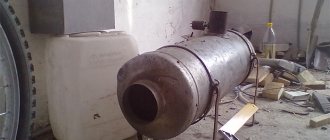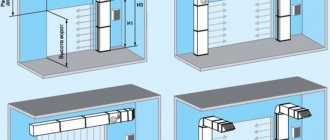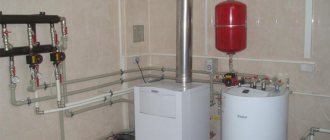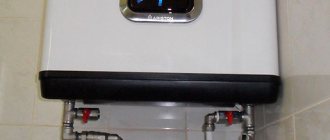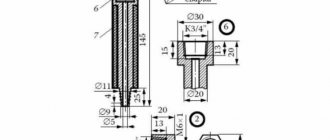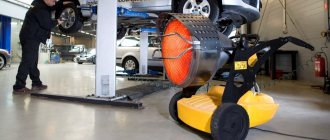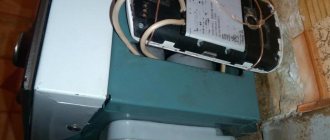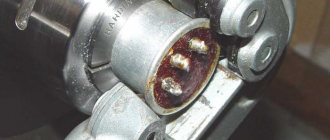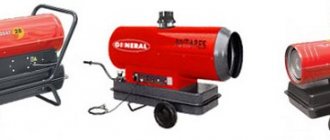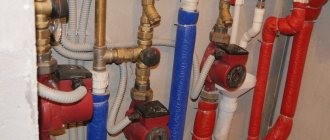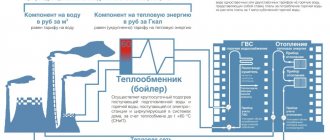What to consider when choosing
The main selection criterion is the thermal power of the device.
A correctly selected parameter will not only help to optimally heat the room, rationally using electrical energy, but will also help maintain the functionality of the gun for a long time. Thermal electric guns can be calculated using the formula:
Р=VхТхК, kW
where V is the volume of the room; T – temperature difference between outside and inside the room; K – coefficient of thermal insulation of walls.
- K=3...4 – walls made of boards or steel corrugated sheets;
- K=2...2.9 – walls made of brick in one layer, roof without insulation, simple windows;
- K=1...1.9 – standard wall, roof and insulated windows;
- K=0.6...0.9 – walls made of two layers of brick, there is additional thermal insulation, high-quality plastic windows, additional thermal insulation of the roof.
The final result calculated using this formula is measured in kcal/hour.
To convert to watts, you need to multiply the resulting number by 1.16.
For rooms with an area of 5-6 m², 0.5 kW devices are suitable.
For every 2 additional m² we add 0.25 kW to 0.5.
In this way, the required power of the heat gun is determined.
The market for electric heat guns offers mobile and stationary options, so before purchasing, you should decide which one is more appropriate in your case.
If you intend to use the device constantly in the same room, for example, for a summer house, then you can purchase a stationary gun.
If you plan to use it as an additional heat source or the frequency of use is not too high, then it is wiser to take a mobile variety.
Pay attention to the design of the heating element. In rooms where people are often present, you should choose models with a closed thermoelement
In rooms where people are often present, you should choose models with a closed thermoelement.
Otherwise, human health may be negatively affected by the combustion products of debris particles that end up on the heating element.
A wide range of products allows you to choose the housing option that best fits into the environment.
You should also pay attention to the material from which it is made - choose the one that is most resistant to heat.
The noise level produced by the gun is of no small importance when installing it in rooms with people. To avoid discomfort, we recommend models with a noise level not exceeding 40 dB
To avoid discomfort, models with a noise level not exceeding 40 dB are recommended.
If the determining factor is the power of the device, for example installed on a construction site, then in this case the effectiveness will be much more important than the sound impact.
And, of course, an important factor is the cost of an electric heat gun.
It would be irrational to buy an expensive, powerful device for a ten-meter room.
And for large areas, such as construction sites, warehouses, and industrial premises, powerful industrial electric heat guns are needed, the cost of which can be 30-40 thousand rubles.
Taking into account the combination of all these factors, you can choose the most optimal option for an electric heat gun
Communications liner
It is necessary to take into account that the heating main must provide the required cross-section (the diameter must meet the technical requirements). And yet, the necessary flow of coolant through the fan heater must be ensured. If the diameter of the pipes and the temperature of the coolant are sufficient, but the speed of movement (flow) is very weak, this will negatively affect the thermal power of the device!
Also, think about how to supply power and control circuits. Calculate the required distances to purchase the required footage of electrical wire.
And one moment. Make sure that the wall (or ceiling) on which the fan heater will be mounted is of sufficient strength to withstand the load.
Characteristics of electric heat gun
This powerful device simultaneously performs several functions: it heats the room, ventilates the air and dries it. This is probably why the electric heat gun is so popular and in demand.
It is used not only on construction sites for heating and drying walls, but also in any garage when repairing a car, in the basement, in warehouses, in shops and country houses. Rectangular guns attach well to the wall, while cylindrical guns are ideal for spot heating.
The principle of its operation is quite simple: with the help of a powerful fan, air is driven through the heating element and distributed throughout the room. The air in the room heats up very quickly, so this type of air heater is most often used in winter.
Diagram of a gas heat gun.
Using an electric heat gun is convenient because you do not need to coordinate its installation with numerous regulatory authorities. These devices are reliable and durable.
Those devices that operate on a voltage of 380 V have a power of up to 25 kW. The temperature is adjusted using step-by-step starting, and there are all the necessary overheating protection functions. The weight of these devices reaches 30 kg. High-quality devices from well-known manufacturers are equipped with heating elements that do not burn oxygen.
Electric heat gun device
Devices of this type can heat both non-residential and residential premises, since they do not burn oxygen and are simply connected and operate using a 220 V or 380 V network. The difference is that electric guns operate with two-phase and three-phase electricity systems. Therefore, before purchasing, you should think about the quality of the wiring installed in the room. It is worth making sure that the device is grounded.
You should not use old wiring to connect a heat gun. It may not be able to withstand heavy loads. It is better to connect a separate line to the device.
Tips for choosing an electric heat gun
When buying any device, everyone wants it to work not only efficiently, but also for as long as possible. Therefore, we choose electric heat guns only from well-known manufacturers.
The body of the device must be made of metal; if a scattering grille is installed, it must also be metal. This is guaranteed to protect the device from deformation due to temperature changes and in the event of a power outage, when the fan stops and the heating elements do not have time to cool down, nothing will happen to the heat gun.
An electric heat gun must have a stable, durable design.
You need to choose a device whose body is marked: 24/2 or 24/1. This means that this heat gun can work around the clock, with a break in operation of 1 or 2 hours.
Pay attention to the presence of overheating protection, a heating level regulator, and an air flow switch (switching fan speed). A huge advantage is the presence of a service center in your area
A huge advantage is the presence of a service center in your area.
Diesel fuel design
In areas where access to power is impossible or limited, it is optimal to make a diesel heat gun with your own hands. It is a little more difficult to make this equipment yourself, unlike its electrical counterpart, since you will need to make two housings and use welding. To heat a room measuring approximately 700 m², about 15 liters of fuel will be required.
Principle of operation
The bottom element in this design is the diesel fuel tank.
A gun is installed directly on top, in which there is a fan and a combustion chamber. Fuel enters the chamber, and the fan transfers heated air. To ignite and transfer fuel, a fuel pump, connecting hose, nozzle and filter will be needed. An electric motor is connected to the fan. Read more: diesel heat guns for heating.
The combustion chamber is installed centrally at the top of the housing. This is an iron cylinder with a diameter approximately 2 times smaller relative to the diameter of the body. Fuel combustion products are removed from the chamber using a vertically installed pipe.
Assembly Features
The lower part must be located at a distance of at least 20 cm from the upper body. To prevent the fuel container from heating up excessively, it must be made of a material with low thermal conductivity. You can also choose a regular metal tank, which must be covered with a thermal insulation layer.
The upper part must be made of thick metal. A piece of metal pipe will do. In the case you need to place:
- fan with electric motor;
- injector with fuel pump;
- combustion chamber with a pipe for removing combustion products.
Afterwards, the fuel pump is attached, and a metal pipe is connected to the tank, with the help of which the fuel is supplied first to the fuel filter, and then to the injector. Protective nets are installed along the edges of the upper body. You need to think about the power supply for the fan to operate in advance. If access to power is limited, you can use a battery.
When operating a diesel heater, safety precautions must be observed. Even at a distance of one meter, the hot air flow can reach 450 degrees. It is not recommended to use this device in enclosed spaces, since the combustion products of diesel fuel pose a danger to humans.
In addition to heaters that run on diesel fuel, other flammable materials are also used for guns, for example, machine oil.
Types of heating elements
Diagram of operation of a diesel heat gun.
An electric heat gun can have two types of heating elements located in it: a heating element in the form of a spiral or a heating element.
When using heating elements, the device heats up more slowly and the heating temperature is not as high as when using a spiral. But such a heat gun is much safer and more durable than a spiral one. This happens because dust and debris do not collect on the heating elements, so accidental fires are minimized. It is the choice of a heat gun using heating elements that is recommended for use in residential premises.
An electric heat gun using a spiral heating element is characterized by almost instantaneous heating, the atmosphere in the room quickly becomes comfortable for further work, but at the same time some of the oxygen is burned. Therefore, it is not recommended to use it in residential enclosed spaces; it is better to use such a device in a garage, outbuildings, etc.
These air heaters can operate at voltages of 220 V and 380 V.
Master
Gas heat gun of any model - instructions:
| Instructions for Master 430 CR | Download (25 MB) |
| Instructions for Master 440 CR | Download (21.1 MB) |
| Instructions for Master 450 CR | Download (26.2 MB) |
| Instructions for Master BLP 15 M | Download (1.02 MB) |
| Instructions for Master BLP 15 M DV | Download (1.02 MB) |
| Instructions for Master BLP 30 E | Download (1.02 MB) |
| Instructions for Master BLP 30 M | Download (1.02 MB) |
| Instructions for Master BLP 30 M DV | Download (1.02 MB) |
| Instructions for Master BLP 50 E | Download (1.02 MB) |
| Instructions for Master BLP 50 M | Download (1.02 MB) |
| Instructions for Master BLP 50 M DV | Download (1.02 MB) |
| Instructions for Master BLP 53 M | Download (10.1 MB) |
| Instructions for Master BLP 53 M DV | Download (10.1 MB) |
| Instructions for Master BLP 70 E | Download (1.02 MB) |
| Instructions for Master BLP 70 M | Download (1.02 MB) |
| Instructions for Master BLP 70 M DV | Download (1.02 MB) |
| Instructions for Master BLP 73 M | Download (10.1 MB) |
| Instructions for Master BLP 73 M DV | Download (10.1 MB) |
| Instructions for Master BLP 100 E | Download (634 Kb) |
Direct fired diesel heat guns
| Instructions for Master B 35 CED | Download (2.74 MB) |
| Instructions for Master B 35 CEL | Download (6.27 MB) |
| Instructions for Master B 70 CED | Download (2.74 MB) |
| Instructions for Master B 70 CEL | Download (6.27 MB) |
| Instructions for Master B 100 CED | Download (2.74 MB) |
| Instructions for Master B 100 CEL | Download (6.27 MB) |
| Instructions for Master B 150 CED | Download (2.74 MB) |
| Instructions for Master B 150 CEL | Download (6.27 MB) |
| Instructions for Master B 225 CEE | Download (8.05 MB) |
| Instructions for Master B 230 | Download (2.12 MB) |
| Instructions for Master B 355 CEE | Download (8.05 MB) |
| Instructions for Master B 360 | Download (2.12 MB) |
| Instructions for Master BS 230 | Download (2.12 MB) |
| Instructions for Master BS 360 | Download (2.12 MB) |
Diesel heat guns with indirect heating
| Instructions for Master BV 110 E | Download (2.12 MB) |
| Instructions for Master BV 170 E | Download (2.12 MB) |
| Instructions for Master BV 290 E | Download (2.12 MB) |
| Instructions for Master BVS 170 E | Download (2.12 MB) |
| Instructions for Master BVS 290 E | Download (2.12 MB) |
| Instructions for Master BV 465 E | Download (2.5 MB) |
| Instructions for Master BV 470 E | Download (3.83 MB) |
| Instructions for Master BV 685 E | Download (2.5 MB) |
Electric heat guns
| Instructions for Master B 2 ECA | Download (765 Kb) |
| Instructions for Master B 3.3 ECA | Download (759 Kb) |
| Instructions for Master B 5 ECA | Download (816 Kb) |
| Instructions for Master B 18 EPR | Download (862 Kb) |
Air heaters using waste oil
| Instructions for Master WA 33 | Download (1.34 MB) |
